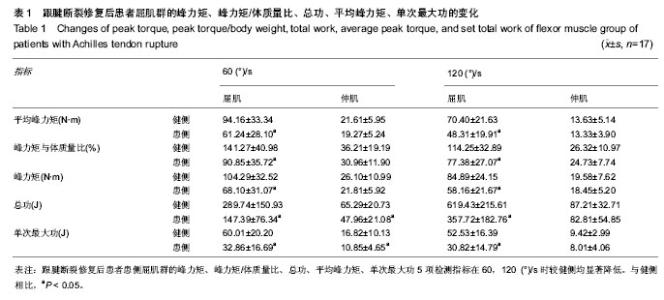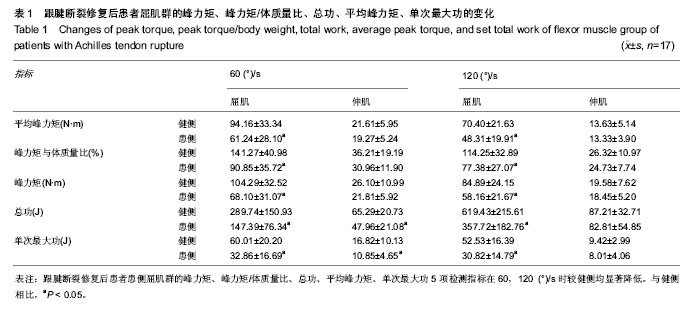| [1] 曲绵域.实用运动医学,第1版[M].北京:北京科学技术出版社,1996.
[2] 查天文,聂梅.医用可吸收合成缝合线缝合跟腱断裂及修复后康复[J].中国临床康复,2002,6(10):1444.
[3] El Shazly O, Abou El Soud MM, El Mikkawy DM, et al. Endoscopic-assisted achilles tendon reconstruction with free hamstring tendon autograft for chronic rupture of achilles tendon: clinical and isokinetic evaluation. Arthroscopy. 2014; 30(5):622-628.
[4] Joshi D, Jain V, Goyal A, et al. Outcome of double bundle anterior cruciate ligament reconstruction using crosspin and aperture fixation. Indian J Orthop. 2014;48(1):42-48.
[5] Almosnino S, Dvir Z, Bardana DD, et al. Ascertaining maximal voluntary effort production during isokinetic knee strength testing of anterior cruciate ligament-reconstructed patients. Am J Phys Med Rehabil. 2014;93(2):169-181.
[6] Lauermann SP, Lienhard K, Item-Glatthorn JF, et al. Assessment of quadriceps muscle weakness in patients after total knee arthroplasty and total hip arthroplasty: methodological issues. J Electromyogr Kinesiol. 2014;24(2): 285-291.
[7] Almosnino S, Brandon SC, Day AG, et al. Principal component modeling of isokinetic moment curves for discriminating between the injured and healthy knees of unilateral ACL deficient patients. J Electromyogr Kinesiol. 2014;24(1):134-143.
[8] Hébert-Losier K, Holmberg HC. Dynamometric indicators of fatigue from repeated maximal concentric isokinetic plantar flexion contractions are independent of knee flexion angles and age but differ for males and females. J Strength Cond Res. 2014;28(3):843-855.
[9] Lin TC, Wang HK, Chen JW, et al. Minimally invasive knee arthroplasty with the subvastus approach allows rapid rehabilitation: a prospective, biomechanical and observational study. J Phys Ther Sci. 2013;25(5):557-562.
[10] Zhou Z, Zheng L, Wei D, et al. Muscular strength measurements indicate bone mineral density loss in postmenopausal women. Clin Interv Aging. 2013;8:1451-1459.
[11] Ben Moussa Zouita A, Majdoub O, Ferchichi H, et al. The effect of 8-weeks proprioceptive exercise program in postural sway and isokinetic strength of ankle sprains of Tunisian athletes. Ann Phys Rehabil Med. 2013;56(9-10):634-643.
[12] de Carvalho Froufe Andrade AC, Caserotti P, de Carvalho CM, et al. Reliability of Concentric, Eccentric and Isometric Knee Extension and Flexion when using the REV9000 Isokinetic Dynamometer. J Hum Kinet. 2013;37:47-53.
[13] Wu X, Zhang S, Liu Y, et al. Do knee concentric and eccentric strength and sagittal-plane knee joint biomechanics differ between jumpers and non-jumpers in landing? Hum Mov Sci. 2013;32(6):1299-1309.
[14] White C, Dixon K, Samuel D, et al. Handgrip and quadriceps muscle endurance testing in young adults. Springerplus. 2013; 2:451.
[15] Moussazadeh AJ, Kohlhof H, Wirtz DC, et al. Hip resurfacing using a modified lateral approach with limited splitting of the gluteus medius muscle results in significant impairment of hip abductor strength. Technol Health Care. 2013;21(5):501-510.
[16] Lubiatowski P, Kaczmarek P, Dzianach M, et al. Clinical and biomechanical performance of patients with failed rotator cuff repair. Int Orthop. 2013;37(12):2395-1401.
[17] Ustun N, Erol O, Ozcakar L, et al. Association with isokinetic ankle strength measurements and normal clinical muscle testing in sciatica patients. J Back Musculoskelet Rehabil. 2013;26(4):361-365.
[18] Brown CA, Carragee C, Sox-Harris A, et al. Prevalence of abnormal patellofemoral congruence in elite American football players and association with quadriceps isokinetic testing. J Knee Surg. 2014;27(1):47-52.
[19] Carlson LA, Koch AJ, Lawrence M. Influence of the Flo-Dynamics Movement System intervention on measures of performance in older persons. Clin Interv Aging. 2013;8: 905-911.
[20] Jenkins ND, Housh TJ, Johnson GO, et al. The effects of anatabine on non-invasive indicators of muscle damage: a randomized, double-blind, placebo-controlled, crossover study. J Int Soc Sports Nutr. 2013;10(1):33. |

